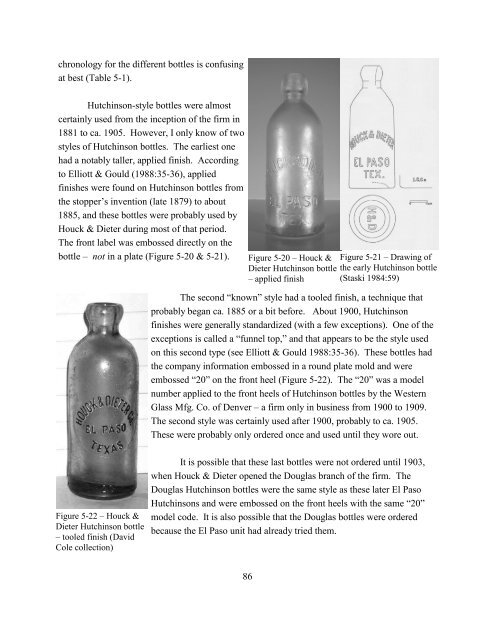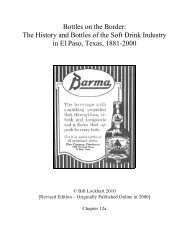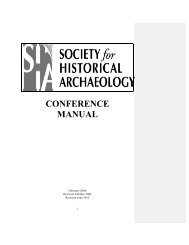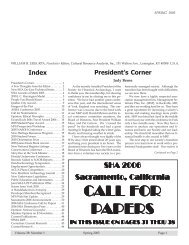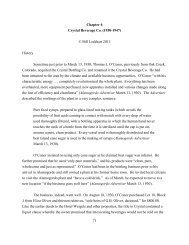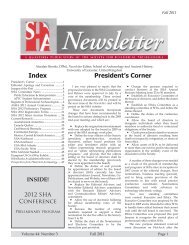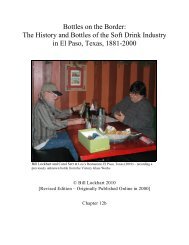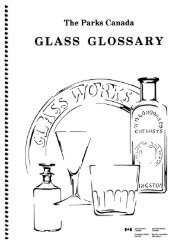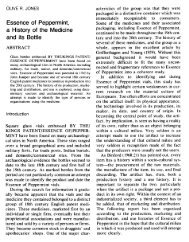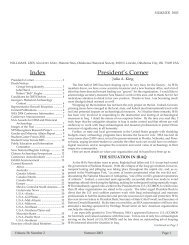Bottles on the Border: The History and Bottles of the Soft Drink ...
Bottles on the Border: The History and Bottles of the Soft Drink ...
Bottles on the Border: The History and Bottles of the Soft Drink ...
You also want an ePaper? Increase the reach of your titles
YUMPU automatically turns print PDFs into web optimized ePapers that Google loves.
chr<strong>on</strong>ology for <strong>the</strong> different bottles is c<strong>on</strong>fusing<br />
at best (Table 5-1).<br />
Hutchins<strong>on</strong>-style bottles were almost<br />
certainly used from <strong>the</strong> incepti<strong>on</strong> <strong>of</strong> <strong>the</strong> firm in<br />
1881 to ca. 1905. However, I <strong>on</strong>ly know <strong>of</strong> two<br />
styles <strong>of</strong> Hutchins<strong>on</strong> bottles. <strong>The</strong> earliest <strong>on</strong>e<br />
had a notably taller, applied finish. According<br />
to Elliott & Gould (1988:35-36), applied<br />
finishes were found <strong>on</strong> Hutchins<strong>on</strong> bottles from<br />
<strong>the</strong> stopper’s inventi<strong>on</strong> (late 1879) to about<br />
1885, <strong>and</strong> <strong>the</strong>se bottles were probably used by<br />
Houck & Dieter during most <strong>of</strong> that period.<br />
<strong>The</strong> fr<strong>on</strong>t label was embossed directly <strong>on</strong> <strong>the</strong><br />
bottle – not in a plate (Figure 5-20 & 5-21).<br />
Figure 5-20 – Houck &<br />
Dieter Hutchins<strong>on</strong> bottle<br />
– applied finish<br />
Figure 5-21 – Drawing <strong>of</strong><br />
<strong>the</strong> early Hutchins<strong>on</strong> bottle<br />
(Staski 1984:59)<br />
<strong>The</strong> sec<strong>on</strong>d “known” style had a tooled finish, a technique that<br />
probably began ca. 1885 or a bit before. About 1900, Hutchins<strong>on</strong><br />
finishes were generally st<strong>and</strong>ardized (with a few excepti<strong>on</strong>s). One <strong>of</strong> <strong>the</strong><br />
excepti<strong>on</strong>s is called a “funnel top,” <strong>and</strong> that appears to be <strong>the</strong> style used<br />
<strong>on</strong> this sec<strong>on</strong>d type (see Elliott & Gould 1988:35-36). <strong>The</strong>se bottles had<br />
<strong>the</strong> company informati<strong>on</strong> embossed in a round plate mold <strong>and</strong> were<br />
embossed “20” <strong>on</strong> <strong>the</strong> fr<strong>on</strong>t heel (Figure 5-22). <strong>The</strong> “20” was a model<br />
number applied to <strong>the</strong> fr<strong>on</strong>t heels <strong>of</strong> Hutchins<strong>on</strong> bottles by <strong>the</strong> Western<br />
Glass Mfg. Co. <strong>of</strong> Denver – a firm <strong>on</strong>ly in business from 1900 to 1909.<br />
<strong>The</strong> sec<strong>on</strong>d style was certainly used after 1900, probably to ca. 1905.<br />
<strong>The</strong>se were probably <strong>on</strong>ly ordered <strong>on</strong>ce <strong>and</strong> used until <strong>the</strong>y wore out.<br />
Figure 5-22 – Houck &<br />
Dieter Hutchins<strong>on</strong> bottle<br />
– tooled finish (David<br />
Cole collecti<strong>on</strong>)<br />
It is possible that <strong>the</strong>se last bottles were not ordered until 1903,<br />
when Houck & Dieter opened <strong>the</strong> Douglas branch <strong>of</strong> <strong>the</strong> firm. <strong>The</strong><br />
Douglas Hutchins<strong>on</strong> bottles were <strong>the</strong> same style as <strong>the</strong>se later El Paso<br />
Hutchins<strong>on</strong>s <strong>and</strong> were embossed <strong>on</strong> <strong>the</strong> fr<strong>on</strong>t heels with <strong>the</strong> same “20”<br />
model code. It is also possible that <strong>the</strong> Douglas bottles were ordered<br />
because <strong>the</strong> El Paso unit had already tried <strong>the</strong>m.<br />
86


